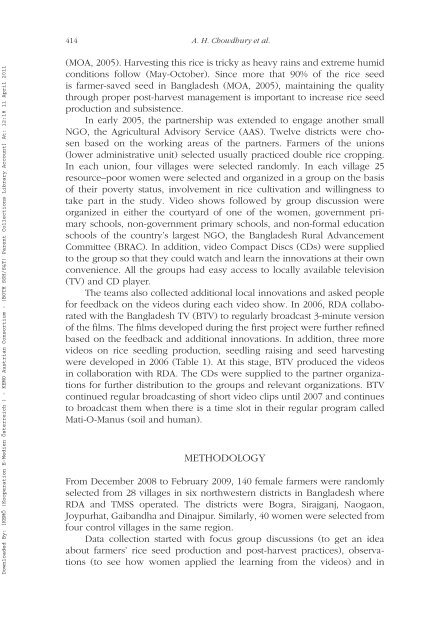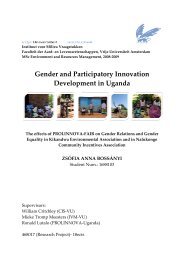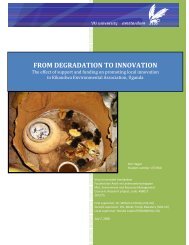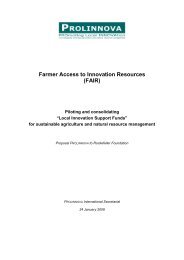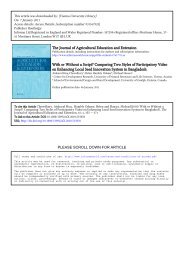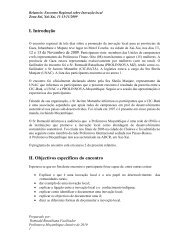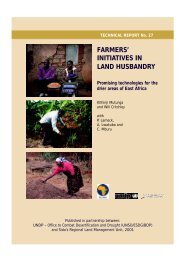Chowdhury et al (2011); PDF file - Prolinnova
Chowdhury et al (2011); PDF file - Prolinnova
Chowdhury et al (2011); PDF file - Prolinnova
Create successful ePaper yourself
Turn your PDF publications into a flip-book with our unique Google optimized e-Paper software.
414 A. H. <strong>Chowdhury</strong> <strong>et</strong> <strong>al</strong>.<br />
Downloaded By: [KEMÖ (Kooperation E-Medien Österreich ) - KEMO Austrian Consortium - (BOTH SSH/S&T) Parent Collections Library Account] At: 12:18 11 April <strong>2011</strong><br />
(MOA, 2005). Harvesting this rice is tricky as heavy rains and extreme humid<br />
conditions follow (May-October). Since more that 90% of the rice seed<br />
is farmer-saved seed in Bangladesh (MOA, 2005), maintaining the qu<strong>al</strong>ity<br />
through proper post-harvest management is important to increase rice seed<br />
production and subsistence.<br />
In early 2005, the partnership was extended to engage another sm<strong>al</strong>l<br />
NGO, the Agricultur<strong>al</strong> Advisory Service (AAS). Twelve districts were chosen<br />
based on the working areas of the partners. Farmers of the unions<br />
(lower administrative unit) selected usu<strong>al</strong>ly practiced double rice cropping.<br />
In each union, four villages were selected randomly. In each village 25<br />
resource–poor women were selected and organized in a group on the basis<br />
of their poverty status, involvement in rice cultivation and willingness to<br />
take part in the study. Video shows followed by group discussion were<br />
organized in either the courtyard of one of the women, government primary<br />
schools, non-government primary schools, and non-form<strong>al</strong> education<br />
schools of the country’s largest NGO, the Bangladesh Rur<strong>al</strong> Advancement<br />
Committee (BRAC). In addition, video Compact Discs (CDs) were supplied<br />
to the group so that they could watch and learn the innovations at their own<br />
convenience. All the groups had easy access to loc<strong>al</strong>ly available television<br />
(TV) and CD player.<br />
The teams <strong>al</strong>so collected addition<strong>al</strong> loc<strong>al</strong> innovations and asked people<br />
for feedback on the videos during each video show. In 2006, RDA collaborated<br />
with the Bangladesh TV (BTV) to regularly broadcast 3-minute version<br />
of the films. The films developed during the first project were further refined<br />
based on the feedback and addition<strong>al</strong> innovations. In addition, three more<br />
videos on rice seedling production, seedling raising and seed harvesting<br />
were developed in 2006 (Table 1). At this stage, BTV produced the videos<br />
in collaboration with RDA. The CDs were supplied to the partner organizations<br />
for further distribution to the groups and relevant organizations. BTV<br />
continued regular broadcasting of short video clips until 2007 and continues<br />
to broadcast them when there is a time slot in their regular program c<strong>al</strong>led<br />
Mati-O-Manus (soil and human).<br />
METHODOLOGY<br />
From December 2008 to February 2009, 140 fem<strong>al</strong>e farmers were randomly<br />
selected from 28 villages in six northwestern districts in Bangladesh where<br />
RDA and TMSS operated. The districts were Bogra, Sirajganj, Naogaon,<br />
Joypurhat, Gaibandha and Dinajpur. Similarly, 40 women were selected from<br />
four control villages in the same region.<br />
Data collection started with focus group discussions (to g<strong>et</strong> an idea<br />
about farmers’ rice seed production and post-harvest practices), observations<br />
(to see how women applied the learning from the videos) and in


